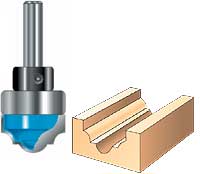
I purchased a large, 2″ radius roundover bit, but it’s so big it doesn’t fit the hole in my router base. How would you go about making a large radius edge on a table?
Sandor Nagyszalanczy: If, by hole, you mean the opening on your router’s plastic sub base, you can make a replacement with a larger hole. If the bit’s too big for your router’s BASE opening, then I would guess the router isn’t large and powerful enough to run a bit that large at all. I’d suggest borrowing or renting a big router, like the Porter-Cable Speedmatic, either the 7518 or 7539 model. These are not only powerful machines with large bases, but they have variable speeda necessity in this case, as you definitely should slow the large-diameter bit’s rotation down considerably from the normal 22,000-25,000 that a non-variable-speed router turns. In lieu of a big router, I would try running your big bit in a shaper, using the special ½” router collet that’s supplied with many shapers as an accessory that attaches to the shaper’s spindle. This is a more difficult method, since you have to move the tabletop past the bit (a drag if the top’s really big).
John Swanson: For a bit of that size, you must have a variable speed router. If the bit is smaller than the opening in your router, you will have to make a new sub-base. If you are using a router table, which I highly recommend, make a new plate that fits your table. Mark the center and use a 2 1/4″ hole saw to make the opening for the bit. Use the lowest speed and feed very slowly. You might have to go to a commercial shop that has a shaper.
Richard Jones: Large diameter bits are primarily used in fixed routers, preferably large commercial overhead pin routers and the like. Often these bits can be used in large variable speed hand-held routers mounted upside down in a router table. By large routers I mean routers that are rated at about 2000 watts or more. It’s awfully easy to get into a dangerous situation, and I suggest the questioner does research into table mounted router use and design.
John Brock: That’s an awfully large bit to run in a hand-held router. This sounds like a job for a shaper, or a large securely anchored table router, but not for a hand-held router. Have you considered using a hand plane to round over the edges, or attach pre-rounded moldings to your table field?
Carol Reed: Make a replacement base for your router with a large bit hole. Do this only with a variable speed router set at the slowest possible speed. If in fact, you really have a 2″ radius bit, it belongs in a shaper. If the bit is 2″ in diameter, the previous advice holds.





